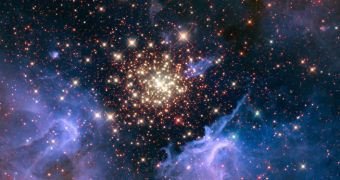Using state-of-the-art computer simulations, and the latest discoveries on the nature of stars, a team of experts has recently compiled a new model of stellar birth. The work might finally solve some of the mysteries related to the development of star clusters, and to the pattern in which these stars spread.
When observing the Milky Way, open star clusters become immediately obvious. They are up to 10 billion years old, and feature mostly old, red stars. Over time, experts determined, the stars in these clusters push away from each other.
This eventually turns the once-tight cluster into a loose association of stars. What astronomers don't know even to this day is how these stars formed. Analyzing the same process in the central regions of the Milky Way is even more difficult.
That area is smothered in thick veils of hydrogen gas and cosmic dust, making visible-light studies impossible to conduct. In order to understand what's going on at those locations, astronomers in an international collaboration combined their data on the oldest star clusters in the Universe.
“The net effect of [cluster being pulling apart] is that their stars eventually become redistributed throughout the Galaxy. This is how we think most of the stars in the Milky Way came to be found in their currently observed locations.” says Nathan Leigh.
The expert, who is a PhD student at the McMaster University, in Canada, detailed the new study this week, at the CASCA 2011 meeting in Ontario. He is also the lead author of the research paper.
“Unfortunately, most star clusters take so long to dissolve that we cannot actually see it happening. But we now understand how this process occurs, and we can look for its signatures by examining the current appearances of clusters,” Leigh said
“We have gone about this by matching up the clusters we make with our simulations to the ones we actually observe. This tells us about the conditions at the time of their formation,” he added further,
Leigh said that all star clusters share a common history up to a point. These common roots go all the way back to the time when the clusters first developed, when the Universe was very young, Universe Today reports.
“This came as a big surprise to us since it suggests that the problem could be much simpler than we originally thought. Our understanding of not only how stars form, but also the history of our Galaxy, just took a much bigger step forward than we were expecting,” he concluded.

 14 DAY TRIAL //
14 DAY TRIAL //